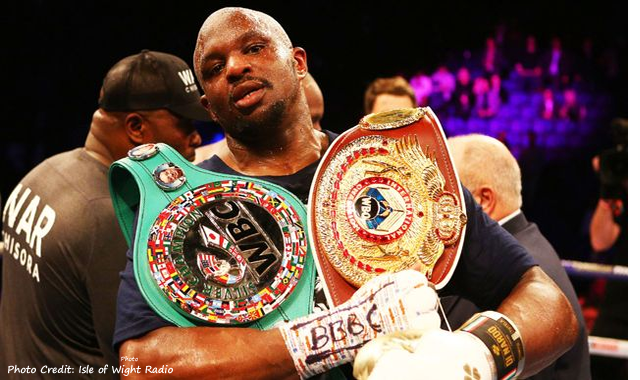Dillian Whyte's Plight with UKAD
Professional Boxing in the United Kingdom: A Closer Look at Dillian Whyte's Plight with UKAD and the British Boxing Board of Control
For those of you who are not following heavyweight Dillian Whyte’s plight with United Kingdom Anti-Doping over a positive test for metabolites of the banned performance enhancing drug Dianabol, you are missing out on one of combat sports most scandalous stories of 2019. A story which seemingly strikes at the very heart of professional boxing in the United Kingdom itself and actually get worse the more you begin to find out. An overview is available from BoxingInsider.com for those in need of catching up on the broader picture and nuances of the story.
In a July 25, 2019 TheGuardian.com article titled, “Dillian Whyte facing lengthy ban from boxing after 'failed drugs test',” Guardian sport and PA Media writes, “The British heavyweight Dillian Whyte is facing a fight to save his career after reportedly testing positive for a banned substance which would leave him facing an eight-year ban if confirmed.
According to TheGuardian, “The 31-year-old Londoner is understood to have returned the positive test, which was conducted by UK Anti-Doping, three days before his victory against the Colombian Oscar Rivas at the O2 Arena on Saturday.” The report goes on to note, “When testing agencies take blood or urine from athletes, they split it into A and B samples, with the latter being a smaller amount used for backup, reanalysis or verification purposes.”
Astonishingly, TheGuardian reports, “When told about the initial positive, Whyte asked for his B-sample to be tested, as is his right, which would not have been possible until this week. This meant UKAD, the sport’s governing body the British Boxing Board of Control, and the World Boxing Council’s chosen testing body the Voluntary Anti-Doping Agency had little option but to allow him to fight.”
Examining the situation closer, what this all in fact actually means is that the UKAD testing procedures are little more than a dog and pony show, the actual results of their testing procedures comically returned so late into the scheduled heavyweight showdown that they were allegedly unable to administrate their own policies within the timeframe necessary to institute the due course of action in their duties. Instead, electing to hold an, “independent panel hearing on fight day,” according to Michael Benson of TalkSport.com whom ultimately gave Whyte the go ahead to compete against Rivas later that night.
 So Dillian Whyte’s A-sample from United Kingdom Anti-Doping flagged for metabolites of the banned performance enhancing drug Dianabol within three days of the fight, whose own policies according to theguardian.com in having the B-sample tested in time prior to the fight prevented them from allowing this option from the Whyte camp to commence, instead, electing to hold an “independent panel” who approved Whyte to compete against Oscar Rivas despite having flagged positive for prohibited substances from their own sanctioned drug test results.
So Dillian Whyte’s A-sample from United Kingdom Anti-Doping flagged for metabolites of the banned performance enhancing drug Dianabol within three days of the fight, whose own policies according to theguardian.com in having the B-sample tested in time prior to the fight prevented them from allowing this option from the Whyte camp to commence, instead, electing to hold an “independent panel” who approved Whyte to compete against Oscar Rivas despite having flagged positive for prohibited substances from their own sanctioned drug test results.
According to United Kingdom Anti-Doping (UKAD), “After a sample is provided by an athlete, the Doping Control Officer (DCO) will send the samples to a World Anti-Doping Agency (WADA) accredited laboratory, maintaining a secure chain of custody. On arrival at the laboratory, the A-sample is analyzed and the B-sample frozen. There are three possible outcomes following sample analysis: Negative, Atypical Finding and an Adverse Analytical Finding.”
United Kingdom Anti-Doping goes on to stipulate, “Where the Notice of Charge is based on an Adverse Analytical Finding, the athlete has the right to request analysis of the B-Sample. If the B-Sample does not confirm the result of the A-Sample then the entire test is considered as negative and the Notice of Charge withdrawn. No further action will be taken against the athlete.”
The veracity of the above words alone a subject worthy of its own article, as if these prohibited metabolites simply materialize on their own if the B sample does not fall in line with the original A-sample results, which should be noted, are in fact one in the same samples to begin with. The half-life of these substances undoubtedly coming into question in the chain of custody, handling and subsequent freezing of the B-samples.
According to an August 15, 2019 BoxingInsider.com article titled, “Dillian Whyte’s B Sample Wasn’t Opened,” author Shane Willoughby writes Eddie Hearn, Whyte’s promoter, “Was asked in an IFL TV interview the week after Whyte’s bout with Rivas, about Dillian Whyte’s B-sample and his response was far from convincing. “People say that there is a B-sample being tested next week, I am not aware of that.” He added, “all I’m aware of is that there was a hearing and he was cleared to fight.”
It’s important to understand, if not for Thomas Hauser at BoxingScene.com who originally reported on Dillian Whyte’s flagged test result several days after the fight had already taken place, it’s questionable how much if any of this information we would be discussing right now. So what exactly is the function of United Kingdom Anti-Doping’s drug testing procedures, who are the long arm of the British Boxing Board of Control (BBBofC), if their own flagged, positive test results are ceremonially dismissed and the athlete allowed to compete anyway due to the curious timing involved in having the B-sample tested and results returned prior to the actual event itself?
Surely, those at the BBBofC and UKAD foresaw the potential for just such an event to occur when these rules and guidelines were originally established? There was another option involved here that apparently remains unreviewed. These governing bodies could have erred on the side of caution and cancelled the fight entirely because the athlete tested positive for metabolites of a banned substance prior to the fight and allowed Whyte’s reported request for the B-sample to be tested to move forward in either confirming or calling into question the results of the initial A-sample.
Instead, a very unusual schedule was followed by the UKAD testing officials which reportedly leads to the B-sample being unable to be tested and the results returned in time prior to the event. And instead, a secret, independent panel was held that ignored their own evidence and allowed an athlete to compete in combat sports against an opponent whose camp was not even notified of the originally flagged test results to begin with.
It’s increasingly apparent that there are holes big enough to drive a truck through in United Kingdom Anti-Doping’s rules, policies, regulations and procedures. In my opinion, the frameworks of the boxing governing bodies in the United Kingdom are entangled in a web of absurdity bordering on near complicity with misconduct within the sport of professional boxing itself. What is the purpose of UKAD’s testing policies and procedures if their own flagged A-sample results are ceremoniously dismissed because having the B-sample tested would not have resulted in an expedited confirmation of the original A-sample prior to a bout where both athletes are literally putting their lives on the line to compete in combat sports?
Who decided the Oscar Rivas camp was not entitled to this information and why wasn’t the secret “independent panel” or even news of Whyte’s originally flagged test result made available to the public prior to the fight? Are we really going to let potentially doped fighters compete against presumably clean athletes? Is that what UKAD and BBBofC are allowing to take place without regard for the health and safety of its athletes? And to this day, the B-sample has apparently yet to be tested and the results made public despite the Dillian Whyte camp reportedly requesting the sample to be analyzed in a stunning lack of transparency from the governing bodies of professional boxing in the United Kingdom that is shaping up to be one of the most scandalous reports in combat sports of 2019.





